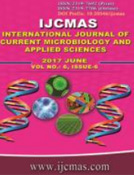


 National Academy of Agricultural Sciences (NAAS)
National Academy of Agricultural Sciences (NAAS)

|
PRINT ISSN : 2319-7692
Online ISSN : 2319-7706 Issues : 12 per year Publisher : Excellent Publishers Email : editorijcmas@gmail.com / submit@ijcmas.com Editor-in-chief: Dr.M.Prakash Index Copernicus ICV 2018: 95.39 NAAS RATING 2020: 5.38 |
Rice bean [Vigna umbellata (Thunb.) Ohwi and Ohashi] is an orphan grain legume, grown in several parts of the country and has a pivotal role as a pulse in supporting the food security of the rural poor people, particularly in hill areas. Multipurpose uses and high nutritional quality of the crop gains its importance in the future food security needs of the country. Despite many useful characteristics, it has not been subjected to systematic breeding, hence a study was undertaken to study the diversity of the available germplasm collected from Himachal Pradesh. In the present study, RAPD markers were employed to study the genetic diversity, a RAPD profile of 64 rice bean genotypes generated 83 bands, of which 47 were polymorphic (56.62% of polymorphism) with Jacard’s similarity coefficient matrices variation from 0.48 to 1.00. Based on the polymorphism exhibited by RAPD markers, 64 rice bean genotypes were grouped into 2 main clusters which again sub divided into several sub-clusters. PCA analysis gave the 12 principal components; among them first two were accounted for 61.65% of the total variability. A biplot plotted, showed a positive correlation among all the traits except crude protein with days to fifty percent flowering and days to fifty percent maturity. Results revealed from the study were preliminary and can be utilized in rice bean improvement programmes and further advanced studies.
 |
 |
 |
 |
 |